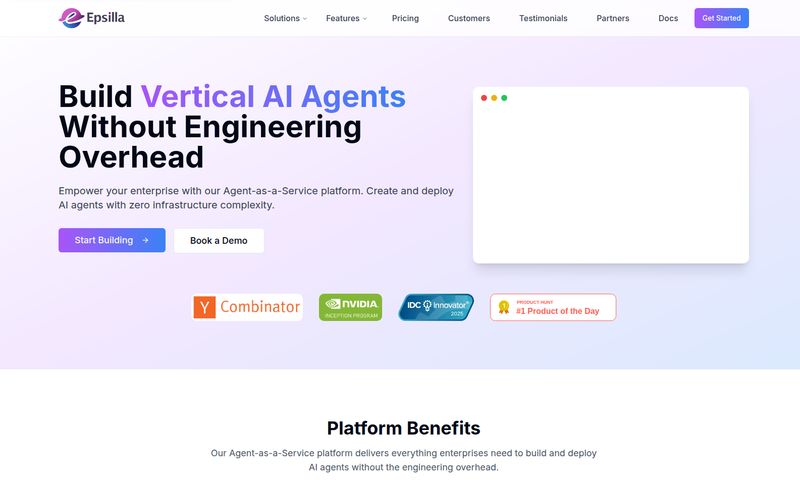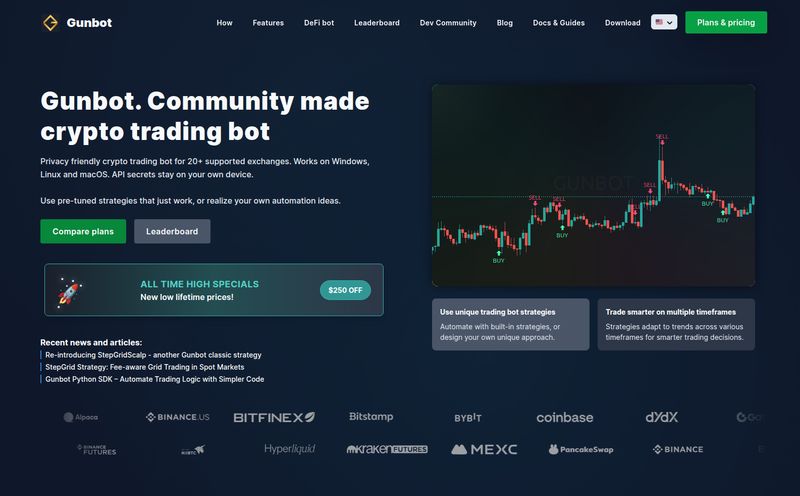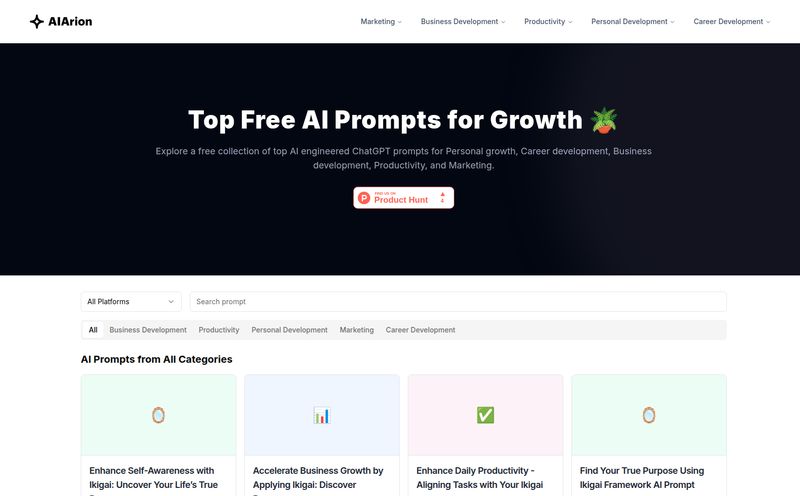I've been in the digital marketing and SEO game for a long time, and if there's one constant I've seen, it's the graveyard of brilliant ideas. You know the ones. The back-of-the-napkin sketches that never become more. The "wouldn't it be cool if..." conversations that fizzle out. Why? Because the gap between a great idea and a functional product is a chasm filled with code, bugs, and endless project management meetings.
For years, we've had two choices: learn to code or find that mythical technical co-founder. Then AI came along, promising to change everything. But let's be real—how many hours and dollars (in the form of API tokens) have you personally wasted trying to coax something useful out of a generic chatbot? "Build me a Facebook clone." Yeah, right. That's the exact frustration I was feeling a few weeks ago, deeply skeptical but perpetually curious, which is how I stumbled upon OnLift. Their headline grabbed me: "Vibe Coding is Nothing Without The Right Prompt." I felt that in my bones.
What Exactly is OnLift, Anyway?
So what is this thing? OnLift isn't another drag-and-drop website builder, and it's not just a fancy wrapper for a large language model. Think of it more like an AI-powered project manager and systems architect, all rolled into one. You feed it your idea—your "vibe"—and its AI-driven prompting engine doesn't just spit out a mountain of potentially buggy code.
Instead, it generates clear, actionable documentation tailored to your exact project. It creates the blueprint. The scaffolding. The plan that you can either build yourself or hand off to a developer without a 3-hour-long explanation session. This focus on documentation is, for my money, the most interesting part.

Visit OnLift
From "Vibe" to Viable Product: How it Works
The term "Vibe Coding" is kinda perfect, isn't it? It’s that initial spark of creative energy. "I want to build an app that's like Airbnb, but for garden gnomes." (Don't steal my idea). You type that into the OnLift prompt box. Instead of getting a mess of unusable code, the platform helps you refine that vibe. It intelligently combines existing solutions and helps you find a unique angle.
Then, it produces the goods: tech stack recommendations, user flows, database schemas. It’s the stuff that turns a fuzzy feeling into a concrete plan. This structured approach is what separates it from just messing around in an AI playground. It's about building a foundation, not just a pretty facade.
The Features That Actually Matter
A lot of AI tools are just bells and whistles. Here's where OnLift seems to deliver real value.
More Than Just Code Snippets: The Power of Documentation
Anyone who's ever inherited a coding project with zero comments knows the unique pain I'm talking about. Bad (or non-existent) documentation is the silent killer of productivity. OnLift tackles this head-on. By generating clear docs from the get-go, it promises to drastically cut down on debugging time. It’s like getting a perfectly written IKEA manual for your app instead of a crumpled, coffee-stained diagram someone drew from memory. This alone is a huge selling point for both developers and the product managers who have to keep them on schedule.
The No-Code Bridge for Idea People
Here's the other side of the coin. OnLift offers no-code development options. This is massive for the entrepreneurs, marketers, and designers out there who have the vision but not the C++ skills. It seriously lowers the barrier to entry, allowing you to prototype and validate an idea without writing a single line of code. We've all seen the no-code movement explode over the last few years, and tools like OnLift are making it smarter and more targeted. It’s not just about building a simple landing page; it’s about architecting a real application.
An AI Muse for Your Next Big Thing
Sometimes the hardest part is the idea itself. The platform also positions itself as a brainstorming partner. By analyzing concepts and combining solutions, it can help you discover innovative business ideas you might not have considered. It’s less of a blank page and more of an interactive whiteboard that talks back.
Okay, But What's the Catch?
No tool is perfect, and my inner SEO cynic always looks for the fine print. OnLift is powerful, but it's not a magic wand. The platform's effectiveness hinges entirely on the quality of the prompts you give it. The age-old "garbage in, garbage out" mantra is more true than ever in the age of AI. You still need to understand what you're asking for and be able to articulate it clearly.
Some might argue this is a flaw, but I see it differently. It forces you to think critically about your own idea. I've found that spending an extra five minutes refining my prompt saves me an hour of headaches later. There’s a bit of a learning curve to becoming a true prompt maestro, but its a skill that pays dividends across all AI tools, not just this one.
Let's Talk Money: The OnLift Pricing Situation
Alright, the million-dollar question. Or, hopefully, the much-less-than-a-million-dollar question. What's this going to cost? This is where things get a little fuzzy. As of this writing, their website doesn't have a public pricing page. In fact, the link I tried led me to a friendly 404 page (kudos for the cute emoji, by the way, it shows personality).
However, the big, bold call-to-action on the homepage is "Start prompting free." This strongly suggests a freemium model or a generous free trial is in play. My guess? They're either still in a beta phase and gathering feedback, or they'll have a tiered system based on usage. For now, it seems you can get your feet wet without pulling out your credit card, which is always a plus in my book.
Who is OnLift Really For?
So, who should be clicking that "Get Started" button? I don't think it's for absolutely everyone, but for a few specific groups, it could be a complete game-changer.
| User Type | Why OnLift Makes Sense |
|---|---|
| Indie Hackers & Solopreneurs | Massively speeds up the prototyping and MVP phase. Go from idea to launchable plan in record time. |
| Product Managers | Create detailed technical specs and user stories to hand off to the dev team, ensuring everyone is on the same page. |
| Startup Founders | Quickly validate business ideas and create a tangible plan to show potential investors or technical co-founders. |
| Developers | Use it to scaffold new projects, automate boilerplate documentation, and get a solid starting point for a new tech stack. |
It's for people who understand that in today's market, speed and clarity are your biggest competitive advantages. It’s for the builders, the dreamers, and the planners.
A Tool for the Thoughtful Builder
After spending some time with it, I'm genuinely optimistic about OnLift. It's not trying to replace developers. It's trying to empower them—and everyone else with a good idea. By focusing on the crucial, often-neglected step of documentation and planning, it addresses a real, throbbing pain point in the development cycle. It’s a bridge between the chaotic energy of a new idea and the structured logic of a well-built application.
The future of building things on the internet isn't about humans or AI; it's about humans with AI. OnLift gets that. And for that reason alone, it's worth keeping a very close eye on.
Frequently Asked Questions about OnLift
- Is OnLift a no-code platform?
- It has strong no-code options, but it's more of a hybrid. It can help you build without code, but it also generates detailed documentation for traditional, hands-on coding projects.
- Do I need to be a developer to use OnLift?
- Not at all. It's designed for entrepreneurs and idea-people too. You can generate the entire plan and documentation without writing code, which you can then use yourself or give to a developer to execute.
- How much does OnLift cost?
- Currently, there's no public pricing information available. However, they offer a "Start prompting free" option, so you can try it out without any initial investment.
- How does OnLift save on AI tokens?
- Their specialized "AI Driven Prompting Engine" is designed to understand development requests more efficiently. This means fewer failed attempts and less back-and-forth, which directly translates to saving time and money on tokens.
- Is OnLift just a fancy version of ChatGPT?
- Not really. While it's powered by AI, it's a specialized tool built specifically for app and website development. It provides structured output like technical documentation and project scaffolding, which is far more targeted and useful for this purpose than a general-purpose chatbot.



